Haslingden Corporation Tramways
History
The first tramway services within Haslingden began on the 27th August 1887, and were operated by the Accrington Corporation Steam Tramways Company. The 4ft 0ins-gauge steam tramway was an extension of Accrington Corporation's Baxenden line, which the ASTCo leased, southwards to the Commercial Hotel in the centre of Haslingden; the line was extended further eastwards three months later, in November 1887, through to the Haslingden-Rawtenstall boundary at Lockgate, and on to Queen's Square in Rawtenstall.
Parliamentary powers for the extension through Haslingden were granted to the ACSTCo on the 5th July 1887, under the Accrington Corporation Steam Tramways (Haslingden and Rawtenstall Extension) Act, 1887. Although some histories state that the tracks within Haslingden and Rawtenstall were owned by the respective corporations, later arbitration documents make it very clear that the company was the owner. By applying for its own powers, the company avoided repeating the mistake it made in Accrington, where it had not only agreed to lease the corporation's newly constructed tramway, but to maintain it too. Unfortunately, Accrington Corporation's tracks were not only poorly laid, but were of a type that was fundamentally unsuited to the use of steam tram engines, such that it quickly deteriorated, a development that was to cost the company significant sums over several years.
In the early twentieth century, there was much discussion in Accrington, Haslingden and Rawtenstall around conversion of the steam tramway to electric traction, and operation by the respective local authorities. As a consequence, Haslingden obtained powers — on the 20th July 1906, under the Haslingden Corporation Act, 1906 — to reconstruct the existing tramway within the borough for electric working, as well as to build circa three miles of extensions. The act also authorised the corporation to operate motor omnibuses in connection with the tramway.
Accrington Corporation began converting its lines to electric traction in 1907, retaining the steam tramway gauge of 4ft 0ins; it formally purchased the engines, trailers and assets necessary to work its lines on the 20th September 1907, reaching agreement with the ACSTCo for the company to continue working the steam services on a contract basis until the end of the year. The last steam tram in Accrington duly ran on the 31st December 1907, electric services to Baxenden (on the Accrington-Haslingden boundary) commencing the following day. On the same day (the 1st January 1908), Haslingden and Rawtenstall Corporations took over the former ASCTCo lines within their respective boroughs, as well as an agreed proportion of the ACSTCo's engines and trailers, with Haslingden Corporation providing the services for both corporations.
Although the 31st December 1907 was the last official day of steam operations within Accrington, there is some circumstantial evidence to suggest that Haslingden Corporation may have run a service through to Accrington as late as the 4th or 5th of September 1908, though probably just to celebrate the end of the steam working, or at least the end of steam working on the Haslingden-Baxenden route.
The first electric services over Haslingden Corporation-owned track (from Baxenden to the Commercial Hotel in Haslingden), which were provided by Accrington Corporation Tramways under a lease agreement, commenced on the 5th September 1908. The services were extended through to Lockgate on the 24th October 1908, the steam trams probably running their last revenue-earning services the day before. Earlier that month, the Haslingden steamers had also ceased to work Rawtenstall Corporation's Lockgate to Rawtenstall line, Rawtenstall Corporation eventually taking over operation (some sources state on the 1st October whilst others state the 20th October). Rawtenstall Corporation operated steam services to the Haslingden boundary for another nine months, until this last remnant of the ACSTCo's system was finally converted to electric traction.
The authorised extensions to the tramway were never built, so Haslingden Corporation only ever owned the 2.93 miles of track, which was the extent of the former ACSTCo lines in the borough; in total, including the lines owned by Rawtenstall Corporation, Haslingden Corporation operated a total of 4.06 miles of tramway. The corporation-owned line ran from the Accrington boundary in Baxenden, broadly southeastwards along Manchester Road, and Blackburn Road to Haslingden, whereupon it turned eastwards along Haslingden Road for a short distance, to the borough boundary at Lockgate.
Whilst Haslingden's electric tramway was worked by Accrington Corporation Tramways under a lease arrangement, agreement was also reached with Rawtenstall Corporation — whose newly electrified line to Lockgate opened on the 23rd July 1909 — which saw the latter's cars work through to Accrington, and the ACT's cars work through to Bacup.
Although Haslingden Corporation instituted an omnibus service as early as the 12th November 1907, it was not a success, the service being withdrawn on the 24th July 1909. Further attempts were made in 1919 and the early 1920s, all of which failed to make a compelling case for expansion of services, including the tramway.
However, following Rawtenstall Corporation's decision to abandon its tramways in 1929, the three neighbouring corporations (Haslingden, Accrington and Rawtenstall) agreed to the closure of the Accrington-Rawtenstall tramway line and its replacement by bus services. Parliamentary powers to operate omnibuses within five miles of Haslingden, both inside and outside the borough boundary, were granted to Haslingden Corporation on the 10th May 1929, under the Haslingden Corporation Act, 1929.
The last tram service over Haslingden-owned tracks, which was operated by the ACT, ran on the 30th April 1930.
Uniforms
All photographs that can be securely dated to the period when Haslingden Corporation operated its own tramway services — i.e., the 1st January to the 5th September 1908 (or possibly the 28th) — show staff wearing informal attire. Engine drivers wore typical railway footplate-like attire, with conductors in fairly smart workman-like attire comprising: jackets, trousers, shirts and ties, and the fashionable headgear of the day, the flat cap. No insignia of any kind appears to have been worn.
Although motormen and conductors working services over Haslingden Corporation's tracks were employees of either Rawtenstall or Accrington Corporations, Haslingden Corporation did in fact employ the services of a uniformed tramway inspector, a fact which is recorded in the council minutes (my thanks to Phil Calvey for this information). Unfortunately, photographs of these individuals do not appear to have survived, so it is unclear what uniforms they wore. It is, however, possible that they wore the same pattern of cap badge that was used later (i.e., after the demise of the trams) on Haslingden Corporation Transport uniform caps.
Further reading
For more information on Haslingden's tramway dealings, see: 'The Tramways of Accrington 1886-1932' by R W Rush; The Light Railway Transport League (1961).
Images
Steam tram drivers and conductors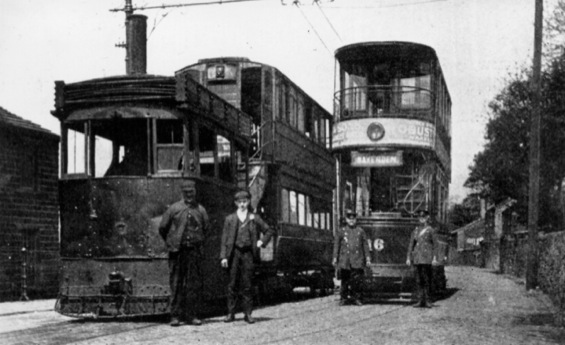
The crews of a Haslingden Corporation Tramways steam tram (unidentified) and Accrington Corporation Tramways electric Tramcar No 16 pose for the camera at Baxenden — the photograph was taken between January and September 1908, when Haslingden ran its own steam trams, before handing over operation of the newly electrified section between Baxenden and Haslingden to the ACT. Photo courtesy of the Tramways and Light Railway Society, with thanks to David Voice.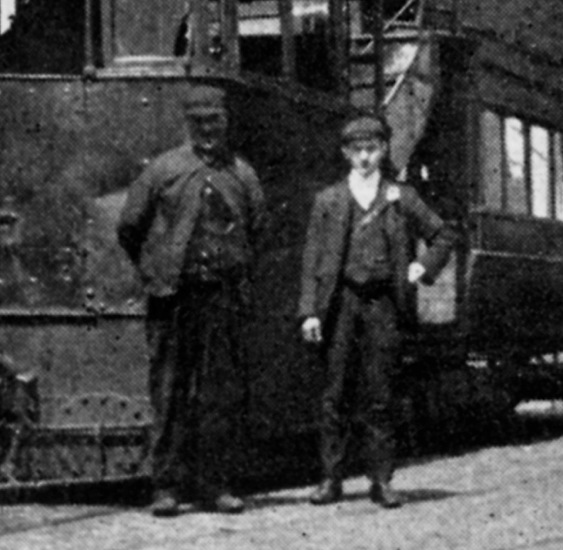
An enlargement of the above photograph, which shows the driver (in very grubby railway footplate-like attire) and the conductor (in informal attire).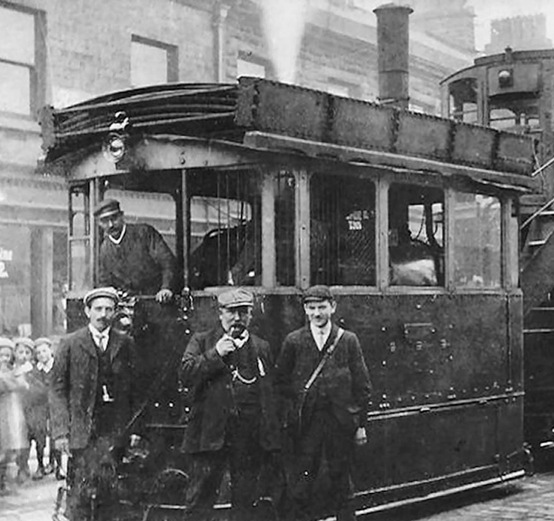
A crowded street scene, apparently depicting the last 'steamer' from Haslingden, presumably at Baxenden, and supposedly taken on the 5th September 1908. An electric tramway standard is visible in the larger photograph. The conductor (right) is wearing an informal jacket and a flat cap. Photo courtesy of Duncan Holden.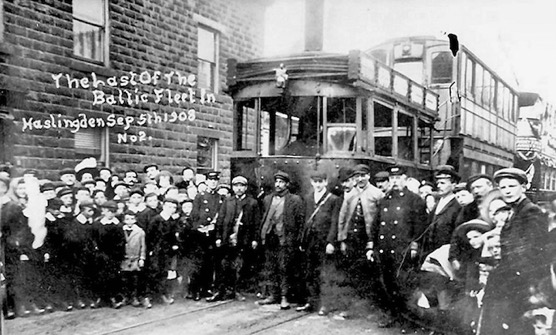
Another photograph purportedly taken on the 5th September 1908, presumably once again at Baxenden given the presence of an electric tramcar behind the steam trailer. The uniformed conductor and motorman are presumably the crew of the ACT tramcar. Photo courtesy of David Gladwin, with thanks to Trevor Preece.
Senior staff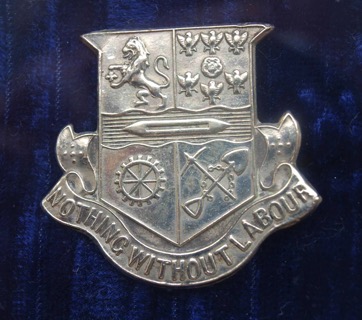
A Haslingden municipal device badge — nickel. This badge was definitely worn on the caps of uniformed Haslingden Corporation Transport employees after the demise of the tramway. It was potentially also worn by Haslingden Corporation inspectors during the tramway era, though photographs that would either prove or refute this are yet to come to light. Photo courtesy of Richard Hargreaves.